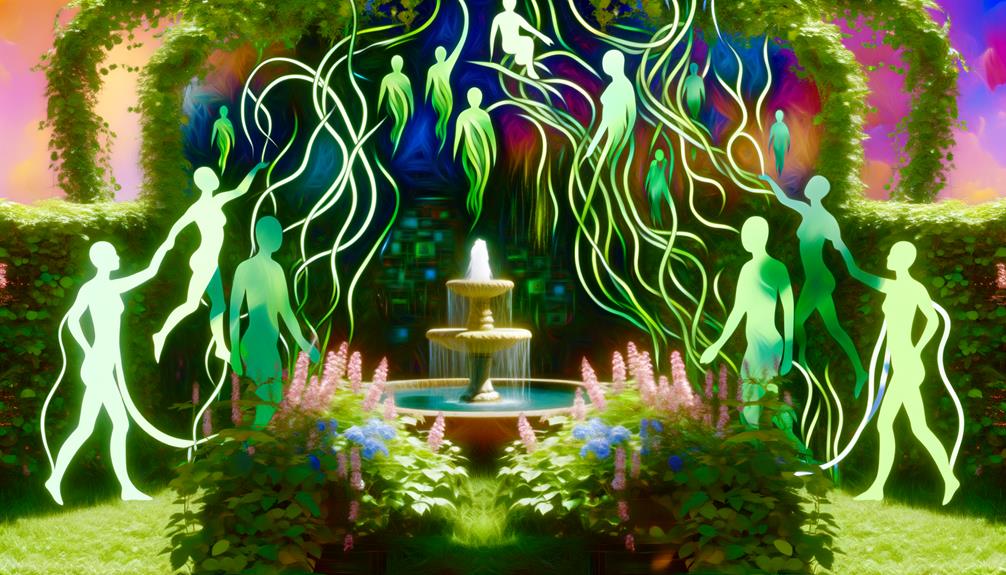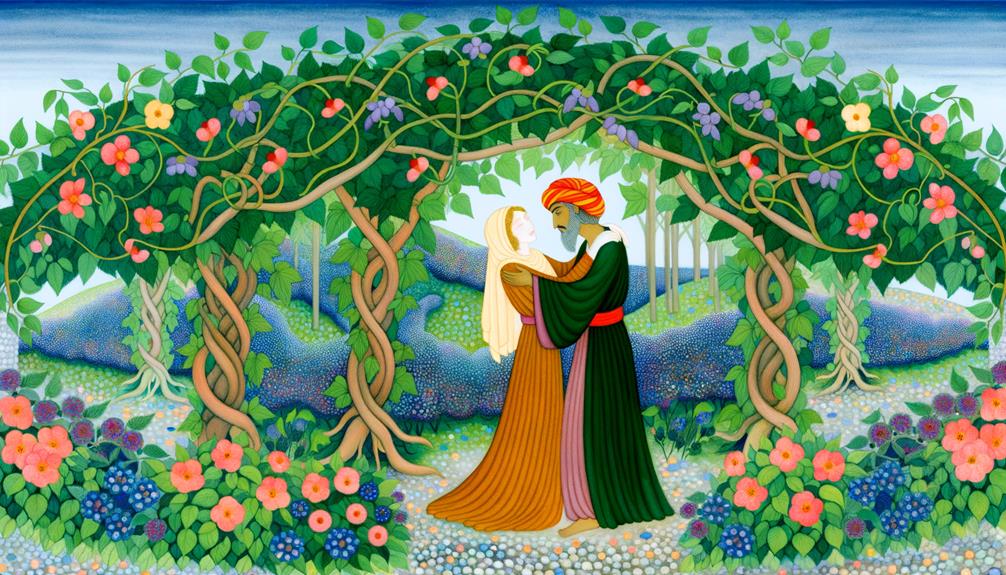Song of Songs Meaning in the Bible: Divine Love Poem
The Song of Songs, or Song of Solomon, is a enchanting biblical text that intertwines poetic imagery with profound theological significance. Rooted in ancient Near Eastern literary traditions and likely composed during the post-exilic period, it mirrors love poetry from Egypt and Mesopotamia.
The text employs a dramatic dialogue structure featuring alternating male and female voices, enriched with nature and architectural metaphors. Allegorically, it represents God’s covenantal love for Israel and Christ’s love for the Church, exploring themes of divine intimacy and human love.
This complex layer of symbolism offers much to reflect upon about divine-human relationships.

Song of Songs Meaning in the Bible: Divine Love and Spiritual Allegory
| Aspect | Details |
|---|---|
| Title | Song of Songs (also called Song of Solomon) |
| Language Origin | Hebrew Shir HaShirim meaning “Song of Songs” |
| Biblical Placement | Old Testament, Wisdom Literature |
| Meaning | A poetic expression of love and desire, often seen as an allegory |
| Interpretation | God’s love for Israel or Christ’s love for the Church |
| Associated Themes | Love, devotion, intimacy, covenant relationship |
Historical Context

Rooted in the ancient Near Eastern literary tradition, the Song of Songs, also known as the Song of Solomon, emerges from a historical context rich with cultural, religious, and poetic influences that shape its unique place within the biblical canon.
This lyrical book, likely composed during the post-exilic period, reflects a milieu where royal courtship and agrarian fertility rites intertwined.
It mirrors the allegorical love poetry of neighboring civilizations like Egypt and Mesopotamia, yet distinguishes itself through its theological undertones.
The Song’s vivid imagery and passionate dialogue speak to a deeper divine relationship, echoing Israel’s covenantal bond with God.
This confluence of historical and cultural elements underscores the text’s theological import, enthralling scholars and theologians alike for centuries.
Literary Structure

The literary structure of the Song of Songs is marked by its intricate poetic imagery, which evokes deep emotional and spiritual resonance.
The text employs a dramatic dialogue structure that alternates between voices, enhancing the sense of relational intimacy and longing.
Additionally, the symbolic language patterns within the poetry reflect profound theological themes, intertwining human love with divine allegory.
Poetic Imagery Analysis
Vivid and evocative, the poetic imagery in the Song of Songs serves as a profound vehicle for expressing the depth and complexity of human love and divine affection, intertwining historical context with theological significance.
The lush metaphors and similes, such as gardens, vineyards, and flocks, create a sensuous landscape that transcends mere physical beauty, hinting at spiritual intimacy.
These images draw from ancient Near Eastern love poetry, yet hold unique theological undertones, reflecting God’s covenantal love for Israel.
The repeated references to flora and fauna not only enhance the emotional intensity but also symbolize fertility, growth, and divine blessing.
This rich tapestry of imagery deepens our understanding of love and faith, inviting readers to explore the sacred mystery of divine-human relationships.
Dramatic Dialogue Structure
Frequently, the dramatic dialogue structure of the Song of Songs reveals a sophisticated interplay between speakers, enhancing the text’s exploration of love and devotion. This nuanced exchange often involves a male and female voice, interspersed with choral interjections, which serves to create a vivid and dynamic narrative.
Historically, this form reflects ancient Near Eastern love poetry, emphasizing the mutuality and equality in romantic relationships. Theologically, the dialogue underscores the sanctity and depth of marital love, mirroring divine love.
Symbolic Language Patterns
Building on the rich dialogical interplay, the Song of Songs employs symbolic language patterns that intricately weave together literary and theological motifs to deepen the text’s exploration of love.
These patterns reflect both the historical context of ancient Near Eastern poetry and the theological richness of divine-human relationships.
Key elements include:
- Nature Imagery: References to flora and fauna (e.g., lilies, gazelles) evoke the beauty and fertility of creation, symbolizing the flourishing of love.
- Architectural Metaphors: Descriptions of the beloved’s body using structural imagery (e.g., towers, walls) suggest strength, security, and admiration.
- Covenantal Language: Terms echoing covenantal promises highlight the enduring and steadfast nature of love, paralleling God’s covenant with His people.
These symbolic patterns enrich the text’s meaning, inviting readers into a deeper theological reflection.
Allegorical Interpretations

Allegorical interpretations of the Song of Songs have historically seen the text as a profound metaphor for the relationship between God and His people, with theologians and scholars drawing parallels between the romantic imagery and spiritual truths.
Early Jewish interpretations often viewed it as an allegory of God’s covenantal love for Israel, reflecting divine fidelity and human response.
Christian theologians, such as Origen and Augustine, extended this allegory to Christ’s love for the Church, emphasizing themes of redemption and divine intimacy.
This interpretive tradition underscores the transformative power of divine love, positioning the Song of Songs as a rich, multi-layered text that transcends its immediate narrative to convey deeper theological insights into the nature of divine-human relationships.
Theological Significance

The allegorical interpretations set the stage for understanding the theological significance of the Song of Songs, where the profound expressions of love and intimacy serve as a metaphorical framework for exploring key aspects of divine-human relationships.
Historically, this text has been seen as:
- God’s Love for Israel: Reflecting the covenantal bond and steadfast love between Yahweh and His chosen people.
- Christ’s Love for the Church: Emblematic of the sacrificial and redemptive love Christ has for the collective body of believers.
- Mystical Union: Highlighting the deep, personal communion between the individual soul and the Divine, often celebrated in Christian mysticism.
These dimensions underscore the multifaceted nature of divine love, offering rich theological insights into God’s relationship with humanity. As theologians have explored these dimensions, many have sought meaning in biblical texts that reveal the depth and complexity of divine affection. This exploration not only enhances our understanding of God’s character but also invites believers to reflect on their own experiences of love and connection. Ultimately, it enriches the dialogue between faith and personal experience, fostering a deeper appreciation for the transformative power of love in the divine-human relationship.
Human Love Themes

The Song of Songs intricately weaves romantic imagery and poetic expressions to celebrate human love, encapsulating both the physical and emotional dimensions of romantic relationships.
This biblical text highlights mutual adoration between the lovers, portraying a profound sense of equality and reciprocation, which was remarkably progressive in its historical context.
Theologically, this celebration of human love serves as a symbolic representation of divine love, reflecting an ideal of relational harmony and spiritual union.
Romantic Imagery Explored
Romantic imagery in the Song of Songs vividly captures human love themes through its poetic and symbolic language, reflecting the deep emotional and physical connections between lovers within its ancient Near Eastern context.
This biblical book employs rich metaphors and similes to explore love’s intensity and passion. Key elements include:
- Nature Imagery: Comparisons to gardens, vineyards, and animals illustrate the natural and flourishing aspects of love.
- Sensory Language: Evocative descriptions of sight, sound, and touch emphasize the lovers’ vivid experiences.
- Symbolic Objects: Items like pomegranates and lilies symbolize fertility, beauty, and desire.
Analyzing these themes within their historical and theological framework reveals a nuanced portrayal of love as a divine and deeply human experience.
Mutual Adoration Highlighted
Mutual adoration in the Song of Songs underscores the profound reciprocity and equality in the relationship between the lovers, embodying a balanced and reciprocal dynamic that transcends mere physical attraction to encompass emotional and spiritual unity.
This mutual admiration is historically significant, challenging patriarchal norms of ancient Near Eastern societies by portraying a relationship where both partners’ voices and affections are equally valued.
Theologically, it reflects the divine ideal of love—one that is not hierarchical but symbiotic.
The lovers’ exchanges of praise and longing paint a picture of love as a holistic communion, where each partner finds their identity and fulfillment in the other, consequently offering a profound model for human relationships rooted in mutual respect and adoration.
Symbolism and Imagery

Throughout the Song of Songs, the intricate use of symbolism and evocative imagery serves to convey profound theological truths about love, beauty, and divine relationship. The text abounds in metaphorical language, drawing from natural and cultural elements of ancient Israel. This approach not only enhances the poetic quality but also deepens the spiritual insights. The imagery crafted in the verses often functions within an overarching narrative, weaving together themes of longing and fulfillment that transcend time. This fusion of artistic expression and spiritual significance reveals the depth of human experience through the lens of divine love, offering “umbrella lyrics and biblical meaning” that resonate across generations. As readers engage with these layers of interpretation, they uncover a richer understanding of both the text and their own relational dynamics with the sacred.
Three primary symbols include:
- Gardens and Vineyards: Representing fertility, growth, and intimate spaces where love flourishes.
- Animals and Birds: Symbolizing various aspects of beauty and freedom within relational dynamics.
- Perfumes and Spices: Denoting the allure and intoxicating nature of true love.
These symbols collectively underscore the sacredness of love, illustrating its complexity and its reflection of divine intimacy.
Modern Perspectives

In examining modern perspectives on the Song of Songs, scholars and theologians often highlight its enduring relevance by exploring its multifaceted interpretations, ranging from allegorical readings to its significance in contemporary discussions on love and spirituality.
Historically, the text has been viewed through various lenses—Jewish and Christian allegorical traditions interpret it as a divine love story between God and His people or Christ and the Church.
Contemporary scholars, however, increasingly recognize its poetic celebration of human love and intimacy. This shift acknowledges the text’s rich emotional and sensual dimensions, offering profound insights into relational dynamics.
Consequently, the Song of Songs continues to resonate, bridging ancient wisdom with modern understandings of love, devotion, and spiritual connection.
Conclusion
To sum up, the ‘Song of Songs‘ reverberates through time, offering a rich tapestry of historical, literary, and theological dimensions.
This ancient text, often regarded as a Shakespearean ode to divine and human love, employs profound symbolism and imagery.
Its allegorical interpretations and modern perspectives continue to inspire and challenge scholars.
The ‘Song of Songs’ remains a demonstration of the enduring complexity of love, both sacred and secular, within the biblical canon.






